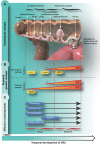Colorectal cancer development and advances in screening
- PMID: 27486317
- PMCID: PMC4958365
- DOI: 10.2147/CIA.S109285
Colorectal cancer development and advances in screening
Abstract
Most colon tumors develop via a multistep process involving a series of histological, morphological, and genetic changes that accumulate over time. This has allowed for screening and detection of early-stage precancerous polyps before they become cancerous in individuals at average risk for colorectal cancer (CRC), which may lead to substantial decreases in the incidence of CRC. Despite the known benefits of early screening, CRC remains the second leading cause of cancer-related deaths in the United States. Hence, it is important for health care providers to have an understanding of the risk factors for CRC and various stages of disease development in order to recommend appropriate screening strategies. This article provides an overview of the histological/molecular changes that characterize the development of CRC. It describes the available CRC screening methods and their advantages and limitations and highlights the stages of CRC development in which each screening method is most effective.
Keywords: DNA test; colorectal cancer; polyps; screening.
Figures


References
-
- American Cancer Society . Colorectal Cancer Facts & Figures 2011–2013. Atlanta, GA: American Cancer Society; 2011.
-
- American Cancer Society . Cancer Facts & Figures 2015. Atlanta, GA: American Cancer Society; 2015.
-
- National Cancer Institute [webpage on the Internet] Surveillance, Epidemiology, and End Results Program. SEER Stat Fact Sheets: Colon and Rectum Cancer. [Accessed March 3, 2016]. Available from: http://seer.cancer.gov/statfacts/html/colorect.html.
-
- ACS [webpage on the Internet] What are the survival rates for colorectal cancer by stage? 2015. [Accessed March 3, 2016]. Available from: http://www.cancer.org/cancer/colonandrectumcancer/detailedguide/colorect...; http://tinyurl.com/grroztx.
Publication types
MeSH terms
LinkOut - more resources
Full Text Sources
Other Literature Sources
Medical

